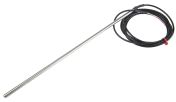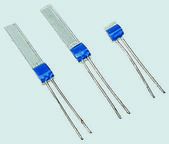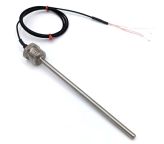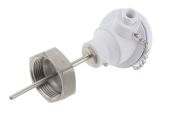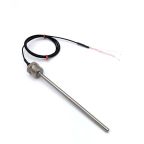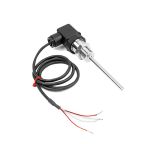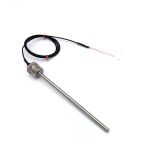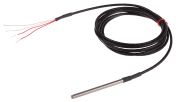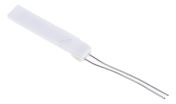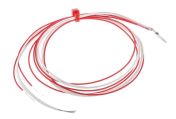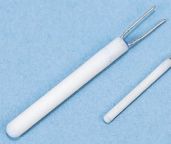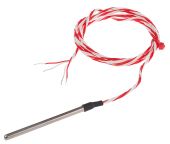RTD Sensors
Resistance Temperature Detectors (RTDs) are precision temperature sensors used in various industrial and commercial settings. These temp devices consist of a resistive element, typically made of platinum, nickel or copper, whose electrical resistance changes with temperature.
This change is precisely measured to determine the temperature, offering high accuracy and stability. RTDs are commonly used in applications requiring precise temperature monitoring and control, such as industrial automation, food processing and HVAC systems.
How RTD Sensors Work
RTD sensors operate on the principle that the electrical resistance of a material changes with temperature. A precisely measured electrical current is passed through the RTD's sensing element, with the accuracy of the RTD depending on factors like the purity of the metal, the design of the sensor and the measurement circuitry.
As the temperature of the element increases, so does its resistance. This change in resistance is then measured and converted into a temperature reading on the device, using a defined mathematical relationship between resistance and temperature.
RTD Types
RTDs are categorised based on their construction method and the materials used for the resistive element. The most common types include:
Pt100 RTD Sensors
Pt100 sensors are the most widely used type of RTD, known for their high accuracy, stability and repeatability. These probes are constructed with a platinum element that has a resistance of 100 ohms at 0°C.
These devices also comply with the IEC 60751 standard, ensuring their quality and performance. These RTD temperature sensors are commonly found in industrial applications, laboratory settings and temperature-critical processes.
Pt1000 RTD Sensors
Pt1000 sensors are similar to Pt100 sensors in terms of their temperature range and tolerances. However, they have a resistance of 1000 ohms at 0°C, resulting in a higher resistance value reading on the device for the same temperature compared to Pt100.
This higher resistance can be advantageous in certain applications, such as those with long lead wires, as it reduces the impact of lead wire resistance on the measurement accuracy.
Thin-Film RTD Sensors
Thin-film RTDs are constructed by depositing a thin layer of platinum onto a ceramic substrate. This manufacturing process allows for miniaturisation and cost-effectiveness.
While generally less accurate than wire-wound RTDs, thin-film RTDs offer faster response times, and are suitable for applications where space is limited, or rapid temperature changes need to be measured.
Wire-Wound RTD Sensors
Wire-wound RTDs are constructed by winding a fine platinum wire around a ceramic or glass core. This design provides high accuracy and stability, making them suitable for demanding applications.
However, they tend to have slower response times compared to thin-film RTDs, and are more susceptible to shock and vibration.
Two, Three, and Four-Wire RTDs
RTD circuits can be configured with two, three, or four wires to compensate for errors in temperature and resistance measurement caused by the resistance of the lead wires.
Two-wire configurations are simplest but least accurate, while four-wire offers the highest precision. Three-wire RTDs are the most common, balancing accuracy and cost-effectiveness.**
Key Features of RTDs**
RTD sensors possess several key features that contribute to their accuracy, reliability and suitability for various applications:
Resistance Temperature Relationship
The core principle of RTD operation is the predictable relationship between the sensor's resistance and temperature. As the temperature increases, the resistance of the sensing element increases proportionally. This relationship is well-defined and allows for precise temperature measurement.
Material Purity
The accuracy and stability of an RTD depend significantly on the purity of the material used for the sensing element. Platinum is the most common choice due to its high purity, excellent stability and wide temperature range. Other materials like nickel and copper are also used, but they may have limitations in terms of accuracy or temperature range.
Construction and Design
RTDs are available in various constructions, including wire-wound and thin-film. Wire-wound RTDs offer high accuracy and stability, but have slower response times. Thin-film RTDs, on the other hand, provide faster response times and are more compact but may be slightly less accurate. The choice of construction depends on the specific application requirements.
Temperature Range
RTDs can operate across a wide range of temperatures, typically from -200°C to 850°C, depending on the material and construction. This makes them suitable for diverse applications, from cryogenic temperature measurement to high-temperature industrial processes.
Accuracy and Stability
RTDs are known for their high accuracy and stability. Platinum RTDs, in particular, offer exceptional accuracy with tolerances as low as ±0.1°C. They also maintain their accuracy over time and are less susceptible to drift, reducing the need for frequent recalibration.**
Benefits of Using RTD Sensors**
RTD sensors offer numerous advantages that make them a popular choice for various temperature measurement applications:
- Enhanced Durability: RTDs are robust and can withstand harsh conditions, including vibration, shock and pressure. This durability ensures reliable performance and a long service life, even in demanding industrial environments.
- Wide Temperature Range: RTDs can operate across a broad range of temperatures, from as low as -200°C to as high as 850°C, depending on the type of RTD and its construction. This versatility allows them to be used in diverse environments and industries.
- Excellent Stability: RTDs maintain their accuracy over time and are less prone to drift compared to other temperature sensing technologies. This stability minimises the need for frequent recalibration, saving time and resources.
- Exceptional Accuracy: RTDs, particularly those using platinum elements, provide highly accurate temperature measurements, often with tolerances as low as ±0.1°C. This precision makes them suitable for applications where even small temperature variations are critical.
- Outstanding Repeatability and Reliability: RTDs consistently deliver accurate and repeatable measurements, ensuring reliable performance and reducing the risk of errors in temperature-critical processes.
How to Use and Test an RTD Temp Sensor
To ensure accurate temperature readings, it's crucial to understand how to test your RTD sensor. A simple test involves using a multimeter to measure the sensor's resistance at a known temperature (e.g., in an ice bath for 0°C). Compare this reading to the expected value based on the RTD's specifications. For instance, a Pt100 sensor should have a resistance of 100 ohms at 0°C. Significant deviations may indicate a faulty sensor.
RTD Connection Configurations
When in use, RTDs can be connected to measuring instruments using different wire configurations:
- Two-wire RTDs: While offering the simplest wiring setup, two-wire RTDs are the least accurate due to the added resistance of the lead wires, which can significantly impact temperature readings.
- Three-wire RTDs: As the most prevalent configuration, three-wire RTDs strike a balance between accuracy and cost-effectiveness. They achieve this by compensating for the resistance in one of the lead wires, improving accuracy compared to the two-wire setup.
- Four-wire RTDs: For applications demanding the highest precision, four-wire RTDs are the optimal choice. They eliminate the influence of lead wire resistance entirely, but this comes with increased complexity in the wiring arrangement.
Signal Conditioning
RTD signals often require conditioning when used to improve accuracy and reliability. Common techniques include:
- Amplification: Because the electrical signal from an RTD can be quite weak, amplification increases its strength, making it easier to measure accurately. This is often done using an amplifier circuit that boosts the signal voltage or current.
- Linearization: The relationship between resistance and temperature in some RTDs isn't perfectly linear. Linearisation techniques, either through circuit design or software, correct for this nonlinearity to ensure accurate temperature readings across the entire measurement range.
- Filtering: Electrical noise and interference from other equipment can distort the RTD signal. Filtering techniques, such as using low-pass filters, help to remove unwanted noise and ensure a clean signal for accurate measurement.
- Cold-Junction Compensation: When an RTD is connected to a measuring instrument, the temperature at the connection point (the "cold junction") can affect the reading. Cold-junction compensation techniques account for this temperature difference to ensure accurate measurements, especially when the cold junction is at a significantly different temperature than the RTD.
RTD Probe vs Thermocouple
While both RTD probes and thermocouples are widely used for temperature measurement, RTDs offer distinct advantages in certain applications:
- Wider Measurement Range: Unlike thermocouples, which have a narrower range, RTDs excel at accurately measuring a broader spectrum of temperatures, typically from -200°C to 850°C. This makes them ideal for applications with extreme temperatures.
- Higher Accuracy: Accuracy is paramount in many applications, and RTDs, particularly platinum RTDs, deliver superior precision compared to thermocouples. They can achieve accuracies of ±0.1°C or better, ensuring that even small temperature variations are captured accurately.
- Good Interchangeability: Maintaining consistency is crucial in temperature measurement. RTDs offer excellent interchangeability, meaning that replacing one sensor with another of the same type will have minimal impact on measurement accuracy. This simplifies maintenance and minimises downtime.
Industrial Applications of RTDs
RTDs are essential components in a variety of industrial areas due to their accuracy, stability and ability to withstand harsh environments. This includes:
- Oil and Gas: RTDs monitor temperatures in pipelines, refineries and storage tanks, ensuring safety and efficiency in oil and gas processing.
- Chemical Processing: Precise temperature control is critical in chemical reactions. RTDs — along with temperature controllers — are used to monitor and control temperatures in reactors, distillation columns and other process equipment.
- Food and Beverage: RTDs help maintain food safety and quality by monitoring temperatures in food processing, storage and transportation.
- Pharmaceuticals: In pharmaceutical manufacturing, RTDs ensure precise temperature control during the production of medications and vaccines, maintaining product integrity.
- Power Generation: RTDs monitor temperatures in power plants, ensuring efficient operation and preventing equipment failure.
- Automotive: RTDs play a role in engine management systems, monitoring exhaust gas temperatures and contributing to emissions control.
- HVAC: RTDs are used in heating, ventilation and air conditioning systems to accurately measure and control temperatures for optimal comfort and energy efficiency.
How to Choose the Right RTD Sensor
Choosing the right RTD sensor for your specific needs requires careful consideration of several key factors:
- Temperature Range: To ensure accurate measurements, begin by identifying the specific temperature range your application requires. RTDs are designed to operate within certain temperature spans, so select a sensor that encompasses your needs.
- Environment: The environment where the RTD will be used plays a crucial role in sensor selection. Factors like vibration, moisture, chemicals and pressure can all influence the choice of materials and construction.
- Accuracy Requirements: Different applications demand different levels of precision. Determine the accuracy level needed for your specific use case, and choose an RTD that meets those requirements.
- Response Time: Consider the necessary response time, as RTDs have varying speeds at which they react to temperature fluctuations. Faster response times are essential for applications with rapid temperature changes.
- Physical Size and Mounting Style: Space constraints and mounting options matter. Ensure the RTD's physical dimensions and mounting style are compatible with your application's requirements.
- Cost and Value: While cost is always a factor, consider the long-term value of the RTD. Balance your budget with the required accuracy, features and the sensor's expected lifespan.
- Application-Specific Needs: Finally, don't overlook any unique requirements for your application. These might include long lead wires, specialised configurations or specific materials to ensure compatibility with the substance being measured.
Trusted RTD Sensor Manufacturer, Supplier and Distributor in Australia
RS Australia is a leading distributor of high-quality RTD sensors, from trusted brands like Honeywell, Siemens and Jumo. We offer a comprehensive range of RTDs to meet diverse industrial and commercial needs, including Pt100, Pt1000, thin-film and wire-wound sensors.
Our expertise and commitment to quality make us a reliable source for temperature-related solutions, ranging from temperature switches to heating elements. Whether you need RTDs for precise temperature control in manufacturing, process monitoring or HVAC systems, RS Australia has the right sensor for your application.
Buy RTD Sensors from RS
RS Australia makes it easy to find and order the perfect one. Browse our extensive selection of RTD sensors online, select the solution for your needs, and proceed to the checkout page. Once payment has been made via our various payment options, you’ll be able to track your delivery right to your doorstep.
You’ll be able to enjoy fast and nationwide doorstep delivery within no time, with dedicated customer support services to ensure a smooth and hassle-free experience. For detailed information on delivery services and costs, visit our Delivery Information page.
Popular Searches
Related links
- RS PRO PT100 RTD Sensor 100mm Long Probe, Classe A +200°C Max
- Temperature Transmitters
- RS PRO PT100 RTD Sensor 100mm Long Probe, Class B +200°C Max
- RS PRO PT100 RTD Sensor 30mm Long Probe, Classe A +250°C Max
- RS PRO PT100 RTD Sensor 35mm Long Probe, Class B +250°C Max
- RS PRO PT100 RTD Sensor 100mm Long 1/2 BSPP, +250°C Max
- temperature sensor PT100 4-wire
- RS PRO PT100 RTD Sensor 8mm Long Probe, Classe 1/5 B +600°C Max
